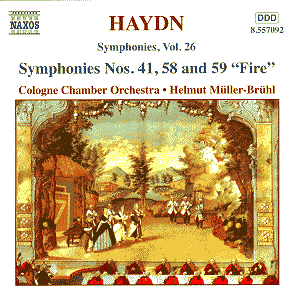The Naxos set of Haydn symphonies has proved most rewarding.
Without exception they are all lively, light, and most tastefully
presented in terms of modern interpretation. This latest disc,
Volume 26, is in keeping with the rest of the series and gives
full value in pleasure. The most notable characteristics of the
collection are the lightness and openness of the playing, mostly
with orchestras which employ modern instruments, but utilise period
idioms. Thus we have very quick outer movements, and not so slow
inner movements, the whole contributing to a most refreshing and
enlightening view of the immediate post-Baroque era. Not for nothing
was Haydn called the ‘father of the symphony’.
Helmut Müller-Brühl and his Cologne
orchestra are well versed in the performances of this period;
indeed, the orchestra was founded in 1923 under the direction
of Abendroth and Klemperer, and the present conductor succeeded
in 1964, following study with Wolfgang Schneiderhan (remember
his Beethoven Violin Concerto with Jochum?). The ensemble played
with period instruments from 1976 to 1987 under the name of Capella
Clementina.
The three symphonies here played are from the
mid-period of Haydn’s output, when he was in the employ of Prince
Nicolaus of Esterhazy. They are all of standard four movement
construction, and the use of horns, trumpets and drums is in the
forefront of the initiation of these instruments into the symphony
orchestra. In all the pieces, the speeds are brisk, the playing
light and the overall impression is one of delight. This series
has been marked by such features, and at the price of each disc,
I cannot recommend them too highly. The recordings are excellent,
with pleasant ambience (as at a Palace chambre), the presentation
good, and even a very readable and knowledgeable booklet with
the disc. If you are looking for a set of Haydn symphonies (or
even individual ones) I would strongly suggest that this series
should come to the fore of your search.
John Portwood
